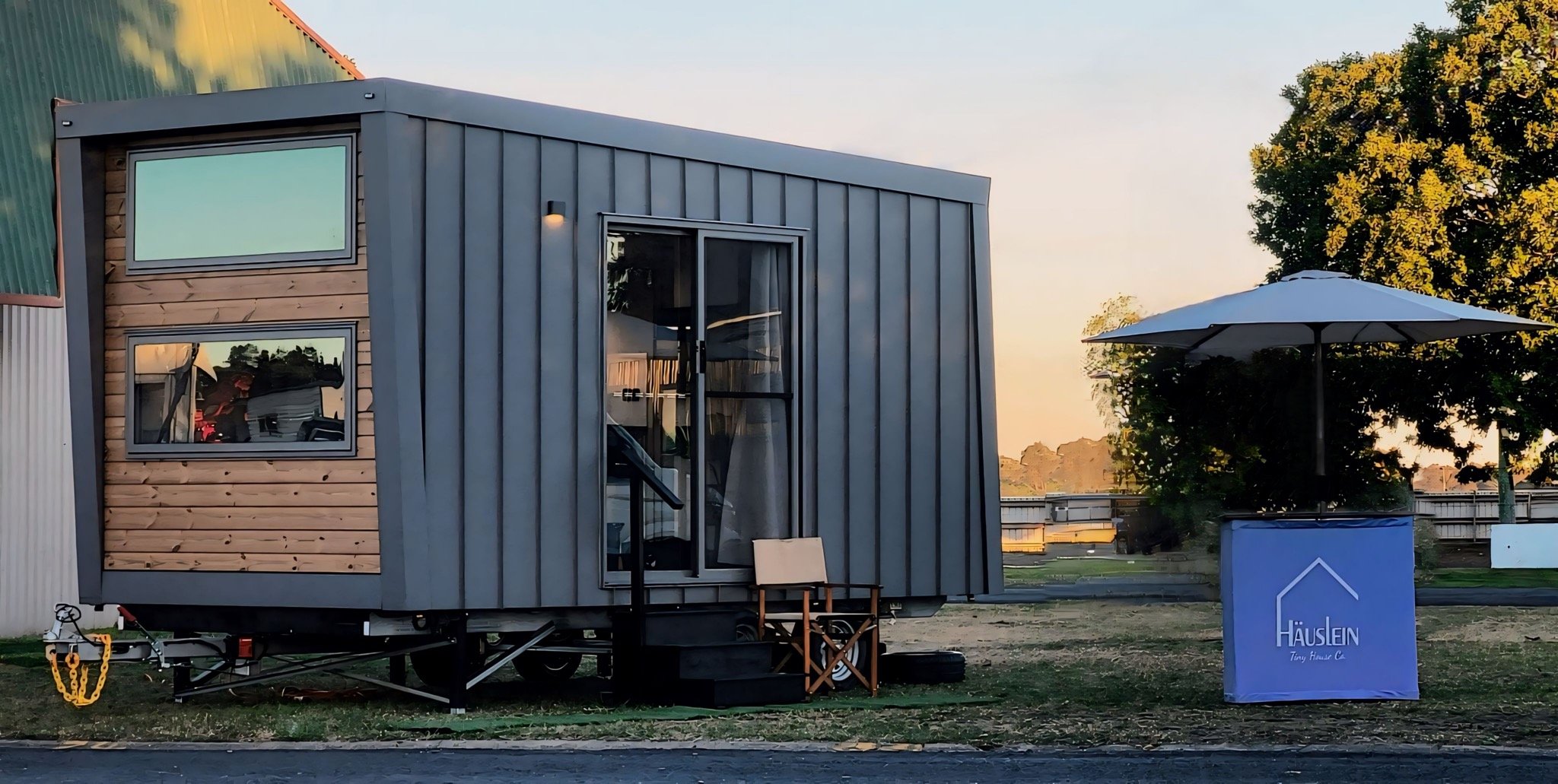Welcome to our Open Day FAQ page! Here, we’ve gathered the most frequently asked questions about our high-end tiny houses and tiny house related issues. If you have any additional questions, feel free to contact us.
TINY HOUSE FAQs
What legal category/ies are Häuslein Tiny Houses recognised under?
Häuslein Tiny Houses are built on trailers with wheels and are not removable from their trailer foundation. They are legally considered a caravan. They come with a VIN number, are road registerable and comply with VSB1 Standards.
What compliance certificates are supplied with Häuslein Tiny Houses?
Häuslein Tiny Houses are supplied with an electrical compliance certificate as well as plumbing registration on the MyInspections Gateway.
What engineering certification is included in a Häuslein Tiny House?
All Häuslein trailers are built and engineered according to the current Rover Regulations. Häuslein is an accredited trailer manufacturer with the Register of Approved Vehicles (RAV).
The law currently only requires the trailer to comply with Australian Standards and Codes. Anything added onto the trailer (the load) just needs to remain within the weight and dimentional requirements of VSB1, nothing more. Therefore, tiny houses on wheels are not required to have any other engineering certification, however, if this changes in the future, we are regularly monitoring requirements and able to adjust to meet them.
How are wet areas in Häuslein Tiny Houses water-proofed/compliant with applicable standards?
Häuslein Tiny Houses are carefully water-proofed in the relevant areas. We do not use tiles in our showers so as to avoid the inevitable ingress through the grout which requires reliance on water-proofing membranes. Our epoxy bathroom flooring performs particularly well in wet areas also. Our tiny houses have been tried and tested, given we are one of Australia’s earliest established tiny house builders.
How is condensation addressed/managed in a Häuslein Tiny House?
At Häuslein we promote ventilation in the management of condensation. Some condensation is unavoidable as it is caused by variation in temperature between inside and outside the home. Our bathrooms are all fitted with extraction fans to remove moisture while showering, windows are strategically placed for maximum cross-ventilation and most tiny houses are fitted with reverse cycle air-conditioning units which are able to function on ‘dry mode’ and greatly reduce humidity.
Using double glazed windows can reduce condensation but is not often viable in a tiny house due to the additional weight. Typically a small amount of condensation is a seasonal and minor issue.
Many tiny houses utilise a composting toilet system. This will also assist in the management of condensation due to the constant drawing of fresh air and expelling of more humid air.
We have customer families who have lived in their tiny houses for a number of years in humid areas and have not experienced any mould issues to date.
Do Häuslein Tiny Houses have an energy efficiency rating?
Häuslein Tiny Houses do not have an official energy rating, however, we have maximised the insulation value as much as possible. We use earthwool insulation batts plus sarking to insulate our tiny homes, as well as double sided closed cell foam underneath the floor, between the floor and the chassis. We use the maximum rated batts for the wall cavity size our tiny houses allow for. A higher rated batt can be squeezed in but will not perform as well when compressed. Obviously in a tiny house, increasing the wall cavity size is undesirable because of the impact on the internal space.
We have tiny houses in some of the coldest and warmest parts of Australia, with high levels of customer satisfaction. They are extremely easy to keep to a comfortable climate with energy efficient reverse cycle AC units and a small space.
Sustainability is important to us and many of our customer tiny houses are fully off grid. Others have low utility costs due to the small and efficient space. The orientation of your tiny house to the sun can also have a big impact on energy efficiency.
What kind of windows/glazing is used in a Häuslein Tiny House?
Häuslein Tiny Houses are built using high quality aluminium windows with tempered and UV treated glass.
Do Häuslein Tiny Houses comply with any specific BAL ratings?
Häuslein Tiny Houses do not comply with any specific BAL rating but may be able to be modified to meet BAL standards. It is important to find out the exact requirements that may exist in your area as different ratings have different requirements and these requirements are regularly updated.
What does Häuslein’s 12 month warranty cover?
Häuslein Tiny Houses are covered for 12 months against all structural defects giving ample time to become aware of any problem areas. These include any defects in the chassis, timber frame and cladding, floorboards, loft structures, internal panelling, cupboards, benchtops/shelving, kitchen and bathroom sinks, ladder and stairs, windows, doors, electrical and plumbing work.
Why is Häuslein’s warranty period not longer?
At Häuslein we pride ourselves on offering some of the highest quality tiny houses in Australia, built to last for generations! The safety and longevity of our tiny houses is of paramount concern to us. We use high quality building materials that last the distance, can tolerate water or other wear in far more superior ways to other common materials and are typically refurbishable. One of our tiny houses survived the Port Macquarie flood some years ago with minimal damage and easily repairable damage such as a clean and fresh coat of oil. You won’t find any chipboard, MDF or vinyl in any of our builds.
Tiny houses are designed to be moved no more than every 6-12 months or so. Due to the relocatable nature of tiny homes, and the uncertainty surrounding how often and how they may be treated in transit over the long term however, tiny houses often have limited warranties. This is simply to protect the companies building them from unreasonable claims.
We have an excellent Customer Care team who are always ready to answer any questions or help work through any problems.
What paperwork is provided with a completed Häuslein Tiny House?
Once your tiny house is complete, it will be delivered with a folder that contains all your vital information including any relevant compliance certificates, warranty guide, maintenance and care guide, as well as any paperwork belonging with any of the tiny house’s components such as air conditioners, rangehoods or hot water units.
How do I go about finding land or a place to park my tiny house?
Please see our guide for ‘How to Find Land For Your Tiny House’
What experiences or tips have Häuslein customers had in dealing with councils?
As is to be expected, our customers have had a variety of experiences with different councils, some very positive, others have had disappointing difficulties.
What are the current reviews underway to the legislation of manufactured homes that tiny houses fall under?
To date in NSW, tiny houses have fallen under the Government Legislation for Manufactured Home Estates, Caravan Parks, Camping Grounds and Moveable Dwellings Regulation 2005
Typically, under Part 3, Subdivision 3, Clause 77b (pages 39-40) no council approval has been required for parking a tiny house (caravan) in connection with a primary dwelling and for a member of the household to live in it full time. However, local laws may still vary and apply and there is a huge discrepancy between local councils as to their openness to tiny houses as viable and accepted long term dwellings. This is the tricky bit and it’s important to check with your local council! Our local Port-Macquarie Hastings council, to our knowledge, have thus far always been favourable.
NSW currently has fairly liberal rules about living in a caravan, but this is not the case everywhere and even these rules are under review. It seems likely that the outcome will have greater restrictions on tiny houses. The official wording is “to provide clarity” but that doesn’t necessarily mean making it easier. For more information and to make a submission to the NSW Government planning framework review for caravan parks, camping grounds, manufactured home estates and moveable dwellings see: https://www.planning.nsw.gov.au/policy-and-legislation/housing/housing-sepp/caravan-parks-manufactured-home-estates-and-moveable-dwellings
Source: Australian Tiny House Association
How does Häuslein view potential legislative changes? If proposed changes pass, will tiny houses still be viable?
At Häuslein we’re passionate about high quality, affordable housing and have a good relationship with our local council, however, the changes being proposed are at a State level. It does seem to be making things more difficult for people at face-value which is disappointing, but changes are still under consideration and Häuslein and many others have made submissions to contribute to the conversation.
At this stage, greater requirements may be applied to tiny houses over the size of 20 square metres. This is one of the reasons we have designed the new Chipper model for long-term living which falls well under the 20 square metre threshold and is easily relocated with most typical 4WDs. We’ve heard of the possibility for ‘fast-tracked’ approval processes for larger models but are yet unsure whether there will be changes to our current designs required. We are ready and able to pivot to meet new requirements, if required and viable, and remain committed to providing excellence in the tiny house sector to the Australian market.
There has been great progress in some local council regions in the acceptance of tiny houses. Groups like the Australian Tiny House Association are working toward seeing a broader acceptance of tiny houses. ATHA suggest builders and customers can help by making personal contact with local elected representatives to ensure that they know tiny houses are an option that a great many people are interested in. They also suggest that we can point out the Shire of Esperance in WA as the first local government area in Australia to welcome tiny house living. Ravensthorpe and Capel Shires, also in WA, have since followed suit and others are actively exploring options. The Surf Coast Shire in Victoria is currently conducting a tiny house trial. Shellharbour in NSW recently announced plans for a trial. Find out more good news on ATHA’s website: https://tinyhouse.org.au/atha-news/
At this stage Häuslein does not foresee that tiny houses will lose their place amongst affordable housing options and it seems clear the government isn’t intending to kick those already living tiny out of their homes. We trust that future direction will be positive as we collaborate toward viable solutions. Being a young industry simply means there is still a ways to go before tiny houses are officially recognised and find their place with greater clarity.
How do I insure my tiny house?
Unfortunately tiny house insurance has been difficult for many! For a while several insurance companies such as NRMA, RACQ, Elders, CIL were insuring tiny houses. But then backed off again. To our current knowledge, CIL and RACQ are insuring tiny houses again.
Because it’s a new industry with limited options, unfortunately insurance companies are monopolising on this and premiums remain high, sometimes around 3K per annum. Shop around.
A benefit of going with a reputable tiny house building company, rather than DIYing, is that you are more likely to receive insurance. Insurance companies understandably have reservations given limited and unclear building standards and therefore increased risk for them to insure.
Have more questions? Feel free to Contact us.
Thank you for joining us on our Open Day!



